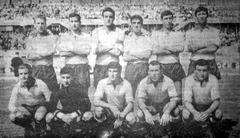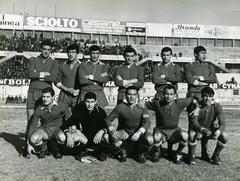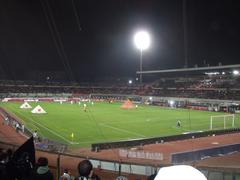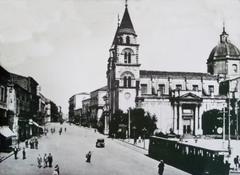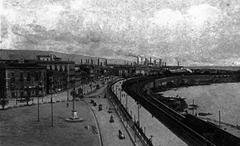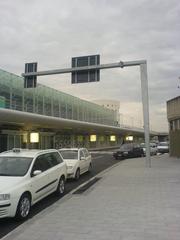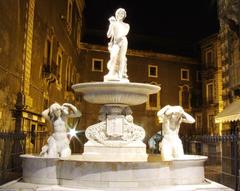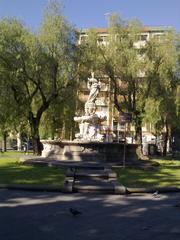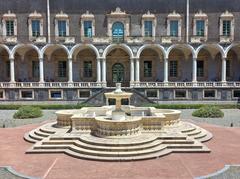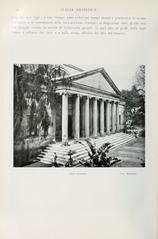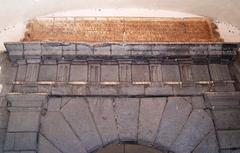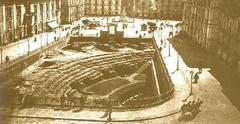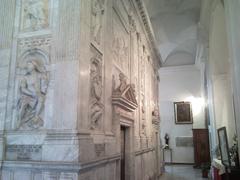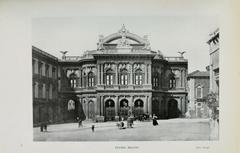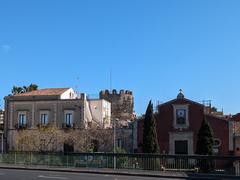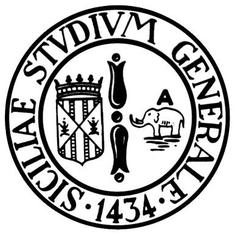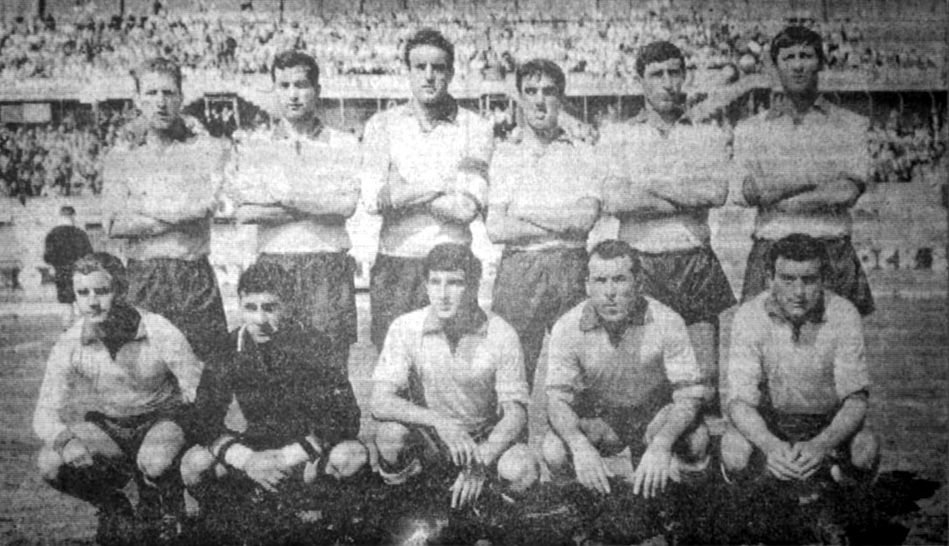
Stadio Angelo Massimino Visiting Hours, Tickets, and Comprehensive Guide to Catania Historical Sites
Date: 14/06/2025
Introduction
Stadio Angelo Massimino, nestled in the Cibali district of Catania, Sicily, is not just a football stadium—it’s a living monument to the city’s sporting spirit, cultural identity, and architectural heritage. Since its inauguration in 1937 as Stadio Cibali, the stadium has played a central role as the home ground of Calcio Catania, hosting generations of passionate fans and historic matches. Blending classic design with modern upgrades, the stadium sits against the dramatic backdrop of Mount Etna and is a gateway to exploring Catania’s rich urban and historical tapestry.
This guide offers all the essential details for visitors—including opening hours, ticketing, accessibility, travel tips, and nearby attractions—so you can fully experience the legacy and excitement of Stadio Angelo Massimino and its surrounding historical sites.
For the most current event schedules, visiting hours, and ticketing, consult the Calcio Catania official website and reputable ticketing partners like PremiumSeating.com. For in-depth historical and architectural background, resources such as Gentleman Ultra and Wikipedia are highly recommended.
Contents
- Introduction
- Practical Information
- Visiting Hours
- Tickets and Entry
- Accessibility
- Getting There
- History and Architectural Evolution
- Cultural Significance and Iconic Moments
- Fan Experience and Matchday Atmosphere
- Facilities and Amenities
- Safety and Modernization
- Nearby Attractions
- Practical Visitor Tips
- FAQ
- Conclusion and Resources
Practical Information
Visiting Hours
Stadio Angelo Massimino is open to the public mainly on match days and during special events or guided tours. For non-match day visits, guided tours may occasionally be organized, especially in the off-season or for groups. Always check the official Calcio Catania website for up-to-date visiting hours and tour availability.
Tickets and Entry
Match tickets can be purchased:
- Online at Calcio Catania’s official website or PremiumSeating.com
- At authorized vendors across Catania
- At the stadium’s ticket office, generally open from 9:00 AM to 6:00 PM on weekdays and with extended hours on matchdays
Ticket prices generally range from €20–€80 depending on the match and seating area. Advance purchase is recommended for high-demand events.
Accessibility
The stadium features upgraded facilities for visitors with reduced mobility, including designated wheelchair-accessible seating and ramps. Recent renovations have focused on enhanced safety and comfort for all attendees. For specific needs, contact the stadium in advance.
Getting There
By Public Transport
- The 4-7 bus line connects the central train station and Piazza Stesicoro to Piazza Spedini, next to the stadium. This bus departs hourly, so plan accordingly (Stadium Guide).
By Car
- From the A18 motorway, exit at Catania (Centro), continue through Via Vincenzo Giuffrida and Via Gabriele D’Annunzio, then follow Via Giuseppe Fava to the stadium (Football Tripper). Parking is limited and mostly street-based; early arrival is essential.
By Air
- Catania–Fontanarossa Airport is about 7 km away. Use taxis or public transit to reach the city center, then connect to the stadium.
History and Architectural Evolution
Origins and Early Years
Constructed between 1935 and 1937 and designed by Raffaele Leone, the stadium initially had a capacity of around 20,000 and was known as “Stadio dei Ventimila.” Its pitch met international standards (110 x 70 meters), and multisport facilities—including an athletics track—reflected its broader vision (Cult of Calcio).
Name Changes and Renovations
The stadium was renamed Stadio Italo Balbo during WWII and reverted to Cibali post-war. Major renovations occurred in the 1960s (to handle growing crowds), the 1980s–1990s (notably for the 1997 Summer Universiade), and in the 2000s and 2020s, with significant upgrades to seating, safety, and amenities (Forza Catania 46). The current capacity is approximately 20,881, with all sectors now featuring individual seats (Wikipedia).
Facilities and Layout
- Four main stands: Tribuna A (premium, with Sky Boxes and restaurants), Tribuna B, Curva Nord (Ultras), Curva Sud (family/general), and Distinti.
- Athletics track and multi-sport facilities including the “Cibalino” training field and PalaSpedini volleyball arena.
- Modern lighting and electronic scoreboard.
- The stadium’s color-coded seating spells out “CATANIA” and creates a striking matchday visual (Gentleman Ultra).
Cultural Significance and Iconic Moments
Home of Calcio Catania
The stadium is the heart of Calcio Catania’s footballing tradition, hosting Serie A and B matches, Coppa Italia fixtures, and key promotion play-offs. The Curva Nord is renowned for its passionate tifosi, choreographed displays, and iconic matchday atmosphere (Stadi Online).
“Clamoroso al Cibali!”
One of Italian football’s most famous moments occurred here in 1961, when Catania’s upset victory over Inter led commentator Sandro Ciotti to exclaim “Clamoroso al Cibali!”—a phrase now legendary in Italian sports culture (Cult of Calcio).
Major Sporting and Cultural Events
Beyond football, the stadium has hosted Italian national team friendlies, international tournaments like the Summer Universiade and Military World Games, and large concerts featuring artists such as Ligabue (Forza Catania 46, PremiumSeating.com).
The 2007 Tragedy
A violent incident during the 2007 Sicilian derby led to the death of police inspector Filippo Raciti and prompted sweeping security reforms, including electronic turnstiles, surveillance, and a reduction in stadium capacity (Cult of Calcio).
Dedication to Angelo Massimino
In 2002, the stadium was renamed for beloved club president Angelo Massimino, whose leadership was instrumental in the team’s modern history (Forza Catania 46).
Fan Experience and Matchday Atmosphere
Passion and Community
Matchdays at Stadio Angelo Massimino are electric, especially in the Curva Nord. Chants, banners, and vibrant crowd displays create an unforgettable experience. The stadium hosts family-friendly events and youth tournaments, further embedding itself into the local community.
Safety and Inclusivity
Ongoing renovations prioritize safety, accessibility, and inclusivity, with designated areas for families and visitors with disabilities. Stadium management ensures a welcoming environment for all spectators (Stadi Online).
Food, Drink, and Merchandise
Concession stands offer Sicilian snacks, while the main stand’s restaurants provide dining options. A club shop sells official Calcio Catania merchandise.
Facilities and Amenities
- Hospitality: VIP Sky Boxes, restaurants, and modernized executive areas
- Restrooms: Located across all stands
- Merchandise: Available at the in-stadium shop
Safety and Modernization
Recent upgrades include high-efficiency LED lighting, emergency systems, electronic access control, and improved signage, ensuring compliance with modern safety standards and a more comfortable visitor experience (Around Catania).
Nearby Attractions
Combine your stadium visit with Catania’s historical and cultural highlights:
- Piazza Duomo: The city’s main square, featuring the Elephant Fountain and Catania Cathedral
- Via Etnea: Lively shopping and dining street
- Roman Amphitheatre: Near Piazza Stesicoro, showcasing Catania’s ancient heritage
- Castello Ursino: A medieval castle and museum
Many bars, cafes, and street vendors in the stadium’s vicinity offer local food and refreshment.
Practical Visitor Tips
- Arrive Early: Especially if driving, as street parking is limited
- Check Match Schedules: For ticket availability and kickoff times
- Weather: Most seating is uncovered—bring sun protection or a jacket as needed
- Security: Expect bag checks and bring valid ID
- COVID-19: Consult the official club website for the latest health guidelines
Frequently Asked Questions (FAQ)
Q: What are the Stadio Angelo Massimino visiting hours?
A: Typically 9:00 AM–6:00 PM on weekdays for ticket offices; longer on matchdays. For tours or special visits, check the official website.
Q: How do I buy tickets?
A: Online at Calcio Catania’s website, through authorized outlets, or at the stadium box office.
Q: Is the stadium accessible for disabled visitors?
A: Yes, accessible seating and ramps are available.
Q: What’s the best way to reach the stadium?
A: Walking from central Catania or using the 4-7 bus line to Piazza Spedini is recommended.
Q: Are there COVID-19 restrictions?
A: Check the latest updates on the Calcio Catania website.
Conclusion
Stadio Angelo Massimino is more than a football ground—it is a vibrant symbol of Catania’s sporting legacy, architectural charm, and civic pride. Whether you’re attending a Calcio Catania match, exploring the stadium’s unique design, or using it as a base to discover Catania’s historic sites, you’ll experience a dynamic fusion of sport, culture, and community.
For up-to-date information, tickets, and event schedules, visit the official Calcio Catania website and trusted platforms like PremiumSeating.com. Download the Audiala app for event notifications and exclusive content, and follow our channels for more guides and insider tips on Catania’s vibrant scene.
References
- Cult of Calcio – Stadio Angelo Massimino history and culture
- PremiumSeating.com – Tickets and event schedules
- Wikipedia – Stadio Angelo Massimino
- Gentleman Ultra – Alternative club guide
- Football Tripper – Visiting guide
- Europlan Online – Stadium data
- Around Catania – Modernization and facilities
- Forza Catania 46 – Stadium history
- Stadi Online – Safety and modernization
